The futures of mobility after COVID-19 has been saved

The futures of mobility after COVID-19 Scenarios for transportation in a postcoronavirus world
25 minute read
22 May 2020
The pandemic has shut millions of people in their homes and disrupted every part of the transportation domain, but leaders can’t simply wait to see how tomorrow’s reshaped mobility ecosystem turns out. We offer four possible scenarios for the future of mobility.
Introduction: The mobility world remade
For roughly a decade, we have witnessed incremental but rapid progress toward a new paradigm for moving people and goods. Powered by quickly evolving technologies, new business models, and shifting societal expectations, a future of mobility that is more sustainable, equitable, efficient, and convenient than today seemed inevitable, even if the precise timing and nature of that transformation was uncertain.
Learn more
Learn more about connecting for a resilient world
Explore the Future of mobility collection
Learn about Deloitte’s services
Go straight to smart. Get the Deloitte Insights app
And then the mobility landscape was seemingly upended.
As the world grapples with the twin crises of a global pandemic and the potential for a severe and prolonged economic downturn, the imminent emergence of a new mobility ecosystem appears in doubt. Worse: The situation is so fluid, uncertain, and complex that acting with certainty or even conviction can feel less bold than reckless.
But leaders can’t sit back and wait to see how it all plays out, and that’s where scenario thinking comes in, clarifying the choices before us—and their implications. To that end, this article explores four possible futures of mobility over the next three to five years. These scenarios take as their starting point a set of high-level scenarios developed by Deloitte and collaborators, which describe the contours of the world based on how severe the pandemic turns out to be and on the degree of cooperation between and within governments in their response.1 From these descriptions, which are industry-agnostic, we explored how the crisis is likely to affect the movement of people and goods, including potential implications for players across the mobility landscape.
Unsurprisingly, we found wide variance across—and within—scenarios. But we also found important commonalities, such an increased emphasis on hygiene in vehicles, or the growing importance of last-mile delivery and e-commerce, upon which companies can act today with at least a modicum of confidence.
Our hope is that business leaders can use these scenarios to begin to identify the central sources of uncertainty, lay out the strategic choices facing different actors, sketch out potential pathways to the future, and highlight the indicators that players across mobility domains should be watching. Doing so now will put us on firmer footing as the environment becomes clearer over the next several months, helping stakeholders from across the transportation spectrum make better-informed choices as they chart a course that accelerates our collective journey to a better future of mobility.
The contours of an emerging mobility ecosystem
As we have chronicled over the last five years, the entire way people and goods travel from point A to point B has been changing, propelled by a series of converging technological and social trends: the rapid growth of carsharing and ridesharing; the increasing viability of electric and alternative powertrains; new, lightweight materials; and the growth of connected and, ultimately, autonomous vehicles.2 The result is the emergence of a new ecosystem of mobility that promises faster, cheaper, cleaner, safer, more efficient, and more customized travel.
While uncertainty abounds, in particular about the speed of the transition, a fundamental shift is driving a move away from personally owned, driver-driven vehicles and toward a future mobility system centered around (but not exclusively composed of) seamless multimodal travel and enabled by driverless vehicles and shared mobility. Far beyond automakers and transit, industries from insurance and health care to energy and media have been considering how to create value in this emerging environment.
As this ecosystem matures, its center of gravity along four key dimensions—leadership, priorities, markets, and personal data—has come into sharper relief.3 These elements move beyond particular technologies or modes and instead describe the fundamental choices and trade-offs with which mobility players are grappling; they provide a rough way to characterize the ecosystem’s essential features.
- Who’s leading? Public sector vs. private sector. Nearly every aspect of mobility involves a complex interplay between government and business actions, and there are a range of activities on which either party can lead. In some cases, agencies might actively seek to shape a mobility vision, priorities, and behavior. In others, they might empower the private sector, allowing companies to lead.
- What’s the priority? Systemwide vs. individual outcomes. Should leaders look to manage mobility to maximize individual consumers’ freedom, flexibility, and diversity of choice, or should individual behaviors and outcomes be actively shaped to benefit the overall network? In cities, agencies might use policy and regulatory tools (including fees and pricing) to encourage greater overall throughput and reduced congestion, for example, or to incentivize or mandate access to underserved communities. In a freight supply network, companies or organizations might limit delivery speed, transparency, and flexibility to better match loads to vehicles across the network.
- How are markets structured? Government regulated vs. market-led. New services and technologies—in mobility and elsewhere—have often outpaced regulation. Should governments proactively create policy, legislation, and regulation that set guidelines within which the private sector must act, or allow businesses a more open market-based approach to drive the pace of innovation and let regulation follow? Note that there is a positive correlation but not a necessary linkage between public sector leadership (Who’s leading?, above) and a regulated approach. Governments can set the agenda and articulate a vision but look to the private sector for the best way to realize that vision using a light-touch regulatory approach.
- How is personal data handled? Collection and aggregation vs. privacy and security. Data is at the heart of the future of mobility, requiring the private and public sectors to align on standards, legal frameworks, and financial terms for secure, robust data exchange. At the same time, concerns about personal privacy and cybersecurity are growing and remain a priority.
The state of mobility before the pandemic
The center of gravity in mobility was in a very different place just months ago. Notwithstanding considerable variation across geographies, modes, technologies, and mobility domains, at the broadest and most aggregated level, our team of experts characterized the precoronavirus mobility landscape in line with figure 1.
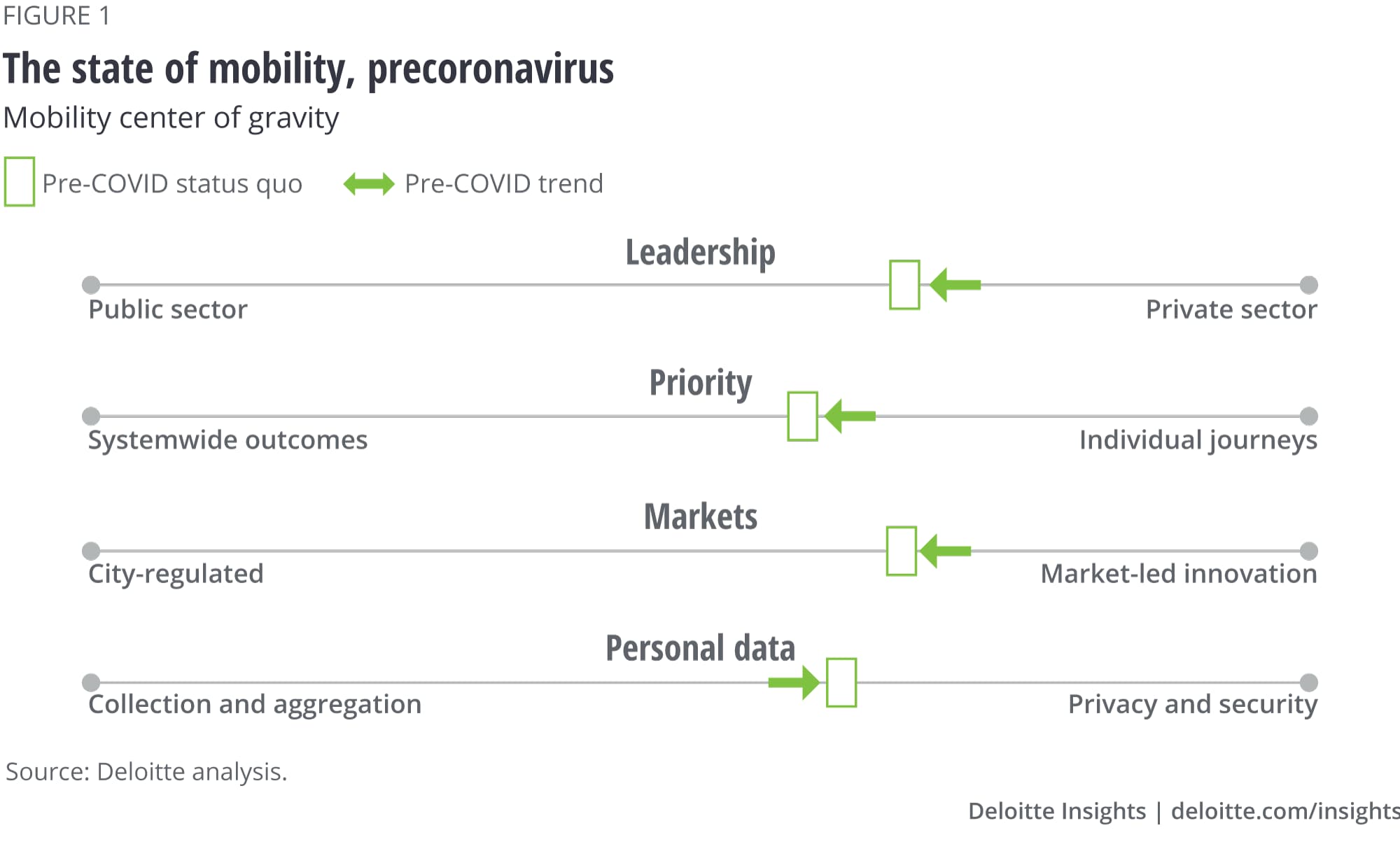
Leadership has tended toward the private sector, driven by the rapid pace of technological innovation (for example, electric powertrains and automated driving systems), new business models (transportation network companies), an expanded set of modalities (drones and electric scooters and bikes), and powered by a steady influx of investment capital. In recent years, the balance has begun to shift toward the public sector, as many cities and others have sought to more actively guide their mobility future.
Priorities have tended to emphasize individual journeys, with many technology and mobility providers (ride-hailing and micromobility but also retailers and shippers/carriers) offering services that increased consumers’ options but with the side effect of worsening systemwide challenges such as congestion, emissions, and clutter in the public right of way. As those systemwide issues have grown more acute, both the public and private sectors have shown increasing interest in addressing them. The dynamic extends to freight, where efforts have increased to connect disparate components, reducing friction and inefficiency.4
Markets tended toward a less regulated environment, with relatively few constraints on businesses and others exploring new forms of mobility. With some exceptions, the development and deployment of autonomous vehicles and advanced driver-assist features, vehicle connectivity, and new modes and business models were not overly hindered by widespread heavy regulation. That, too, had started to shift in recent months, as regulators in multiple jurisdictions began to promulgate more explicit and binding rules.
Personal data tended to favor individual privacy and security, albeit with wide variations across geographies; contrast Europe’s General Data Protection Regulation or the California Consumer Privacy Act with China’s extensive system of monitoring. Amid an emerging “techlash” and increasingly contentious battles over mobility data between cities and the private sector,5 the trend seemed to be moving toward greater emphasis on individual privacy and security.
This assessment of the status quo ante is admittedly impressionistic, albeit informed by our long experience engaging deeply with mobility players across the ecosystem. Even before COVID-19, there was wide variation in how different cities and companies were balancing these different dimensions, as our work with the World Economic Forum on Seamless Integrated Mobility Systems illustrated.6 We expect to see similar variability in a postcoronavirus world, although the pandemic and the global response could drive convergence on some issues.
Twin crises and their uncertain impacts on mobility
Against this backdrop of innovation and contestation, twin crises are buffeting the future of mobility. The first is COVID-19 itself and the measures that have been put in place across the globe in an attempt to slow its spread and manage the public health repercussions. The second is the resulting economic fallout, which seems likely to push the world into a recession of unknown severity and duration.7 These crises, alone or in combination, raise serious, even existential questions for players across the mobility landscape (figure 2).
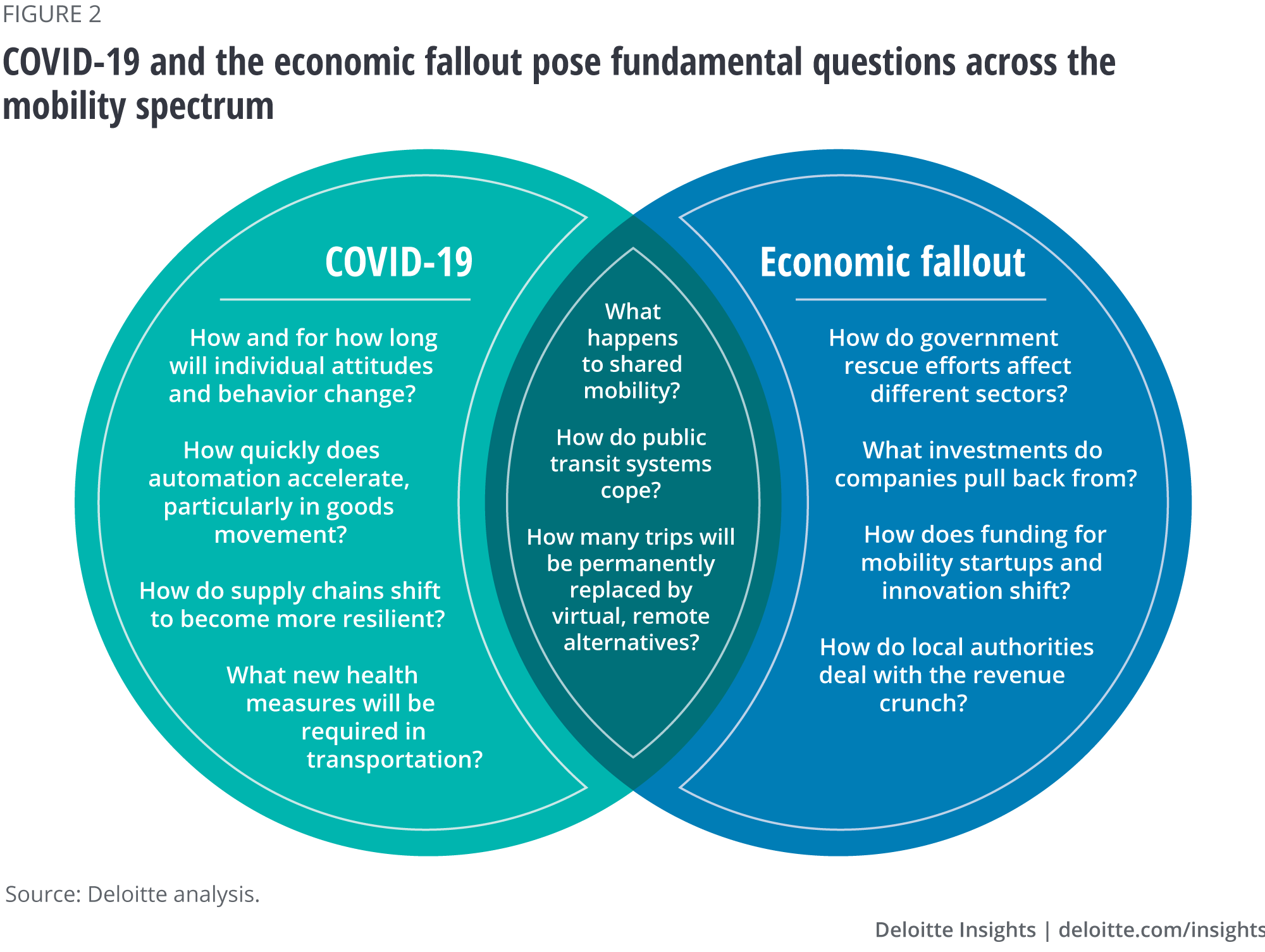
The trajectory of the future of mobility and the impacts on players across the ecosystem is highly uncertain and could vary dramatically depending on how the pandemic evolves, the health of the overall economy, and on the collective decisions made by governments, businesses, and individuals over the coming months. To explore those alternatives, we look at four possible scenarios for a postcoronavirus world.
How to use scenarios
Scenarios are stories about what the future may be like, created through a structured process to stretch thinking, challenge conventional wisdom, and drive better decisions today. They are not predictions about what will happen—they are hypotheses about what could happen, designed to open our eyes to new opportunities or hidden risks.8
We have chosen a three-to-five-year time frame, as it offers a window wide enough for significant change to take place but narrow enough for executives to take practical action now to build their organizational resilience.
Four possible futures of mobility
Deloitte and Salesforce assembled renowned scenario thinkers to develop a series of possible long-term (three-to-five-year) outcomes for a post-COVID-19 world. At the highest level, the postcoronavirus landscape will likely be shaped by the evolution of two key factors: the duration and severity of the pandemic itself, and the degree to which governments collaborate within and between themselves in the response. Based on the key uncertainties, we developed four notional scenarios:
- A passing storm. The COVID-19 pandemic shakes society but, after a slow start, is met with an increasingly effective health system and political response. The virus is eradicated earlier than expected due to coordinated measures by global players to spread awareness and share best practices. Their competence in the crisis renews trust in public institutions. Despite being relatively short-lived, the pandemic causes long-term economic impact. Fiscal and monetary stimulus help blunt the shocks but cannot reverse the losses that small businesses and lower- and middle-income individuals have begun to experience. Tensions sharpen between socioeconomic classes.
- Good company. The COVID-19 pandemic persists past initial projections, placing a growing burden on governments around the world that struggle to handle the crisis alone. Public-private partnerships surge as companies step up to be part of a global solution. New “pop-up ecosystems” arise as companies across industries partner to respond to critical needs and drive much-needed innovation. Social media companies, platform companies, and tech giants gain new prestige. Ultimately, companies shift further toward stakeholder capitalism, with a more empathetic stance on how they can best serve their customers, shareholders, and employees in rebuilding after the crisis.
- Sunrise in the east. The COVID-19 pandemic is severe and unfolds inconsistently across the world. China and other East Asian countries manage the disease more effectively, whereas Western nations struggle with deep and lasting impacts—human, social, and economic—driven by slower and inconsistent responses. The global center of power shifts decisively east as China and other East Asian nations take the reins as primary powers on the world stage and lead global coordination of the health system and other multilateral institutions. The ability of China, Taiwan, and South Korea to contain the outbreak through strong, centralized government response becomes the gold standard.
- Lone wolves. The COVID-19 pandemic becomes a prolonged crisis as waves of disease rock the globe for longer than anyone was prepared for. Mounting deaths, social unrest, and economic free fall become prominent. The invisible enemy is everywhere, and paranoia grows. As isolationism grows, nations put strict controls on foreigners and force supply chains home in the name of local security. Government surveillance is commonplace, with tech monitors on people and their movements.
Each scenario offers a high-level description of the state of technology, society, the economy, the environment, and politics. Building off of those general characteristics, we dove deeper into what mobility might look like in each.
Of course, even in narrowing our focus to transportation, these scenarios largely and necessarily omit the near-infinite variations we will see across geographies. And while these scenarios can be roughly characterized as optimistic or pessimistic based on the course of the pandemic and how governments respond, those labels do not neatly translate to the mobility environment in each future.
Scenario 1: A passing storm
Acute but brief public health and economic crises accentuate some enduring shifts in mobility trends, including increased reliance on e-commerce and home delivery and greater emphasis on sanitation and safety. Despite a temporary pullback, most providers and governments return to their status quo ante roles. “Typical” business cycle downturn dynamics play out, with consolidation taking place across the board, from small mobility startups to larger incumbents.
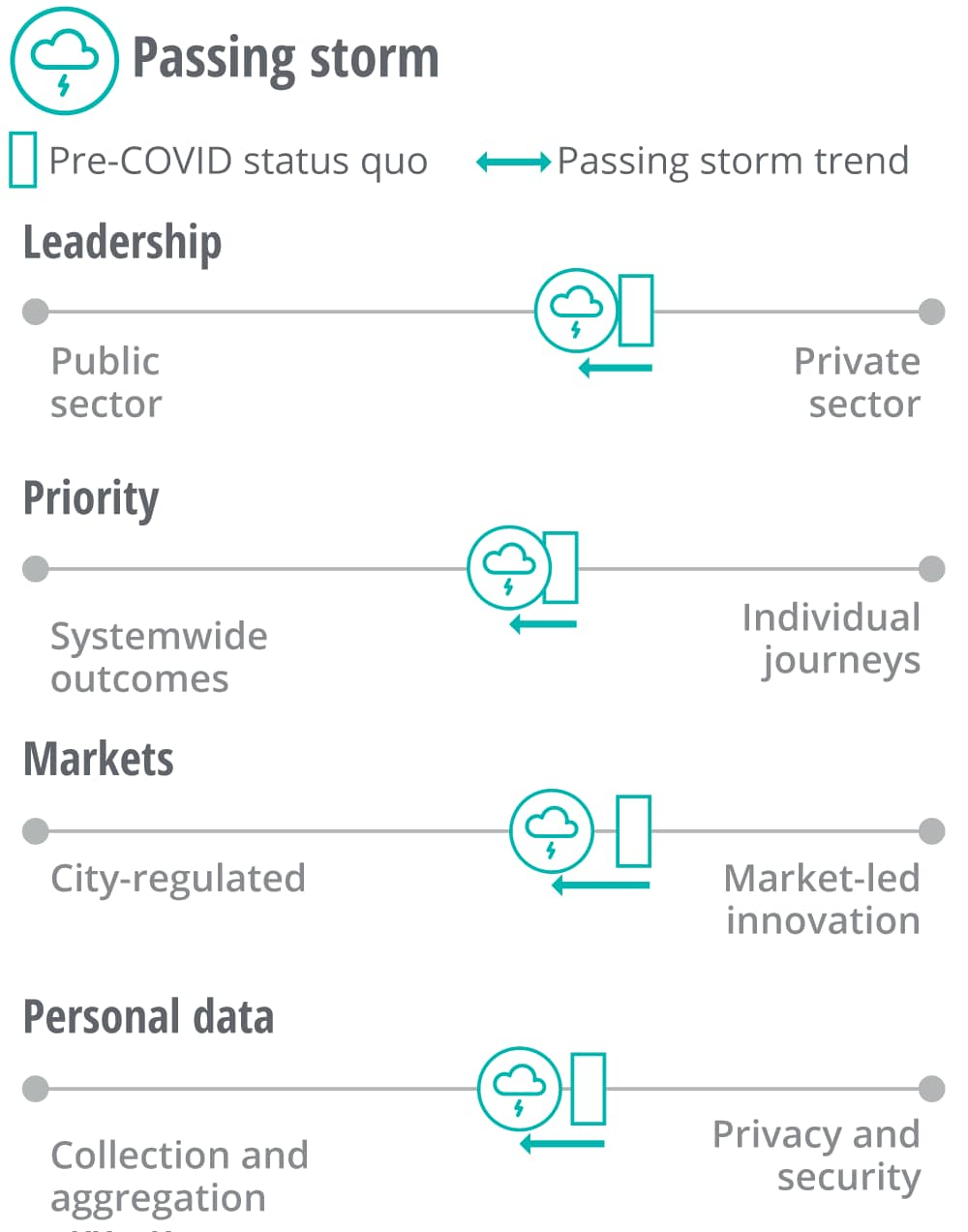
The COVID-19 pandemic, while relatively brief, alters the mobility landscape in enduring ways. Consumers place greater emphasis on vehicle sanitation in cars, buses, trains, and shared bikes and scooters, prompting new self-cleaning materials, certification programs, and form factors—for example, passenger partitions. The turn to e-commerce accelerates, as does the importance of last-mile delivery networks, increasingly enabled by autonomous vehicles and digitization of the logistics value chain. The in-transit experience benefits from advances in digital entertainment and productivity prompted by the pandemic, including, potentially, AR and VR applications.
The mobility ecosystem hits “pause.” Advances in new technologies, modes, and business models come to a temporary standstill as near-term government relief and relaxed regulation in some markets provide a lifeline and legacy incumbents (automotive OEMs, suppliers, and dealers, along with airlines, mass transit agencies, major freight carriers, and others) revert to familiar products and services; government funding aims to restart the economy by getting people back to work. American and European automakers reduce investment in electric vehicles and/or autonomous vehicles, while transit agencies forgo modernizing legacy infrastructure and fleets; the push toward automation is temporarily slowed as governments stress getting people back to work. In parallel, venture funding for riskier, longer-term innovation slows down as the time frames to realize ROI get elongated. The mobility business ecosystem sees a winnowing, as poorly capitalized startups fold and even some well-established players see their businesses threatened. Some well-capitalized technology companies are able to strengthen their market positions.
As travel restrictions ease, some organizations maintain work-from-home options, but in insufficient numbers to affect overall mobility patterns; old habits quickly return, as does congestion and reduced air quality in many cities, potentially exacerbated by the reluctance of some to use mass transit. Growth in at-home delivery clogs streets further. That said, some cities that have embraced more progressive, sustainability-focused approaches may try to lock in new mobility patterns by repurposing infrastructure toward active modes (biking, walking) and could represent the vanguard for implementing mobility innovation. The net result could be an increasingly bifurcated mobility landscape, with low-density cities and rural areas even more reliant on internal combustion engine-powered personal cars and crowded metropolises moving closer to seamless integrated mobility anchored in public transit and active modes.
Given the modest effect of the pandemic and economic fallout, we continue to see wide variation in approaches to mobility. In many places, successful efforts to combat the virus invigorate governments, prompting them to redouble initiatives around sustainability—in Europe and Asia, in particular, public authorities work to accelerate the shift to electric and alternative fuel vehicles via expanded charging infrastructure, incentives, and bans on internal combustion engines.
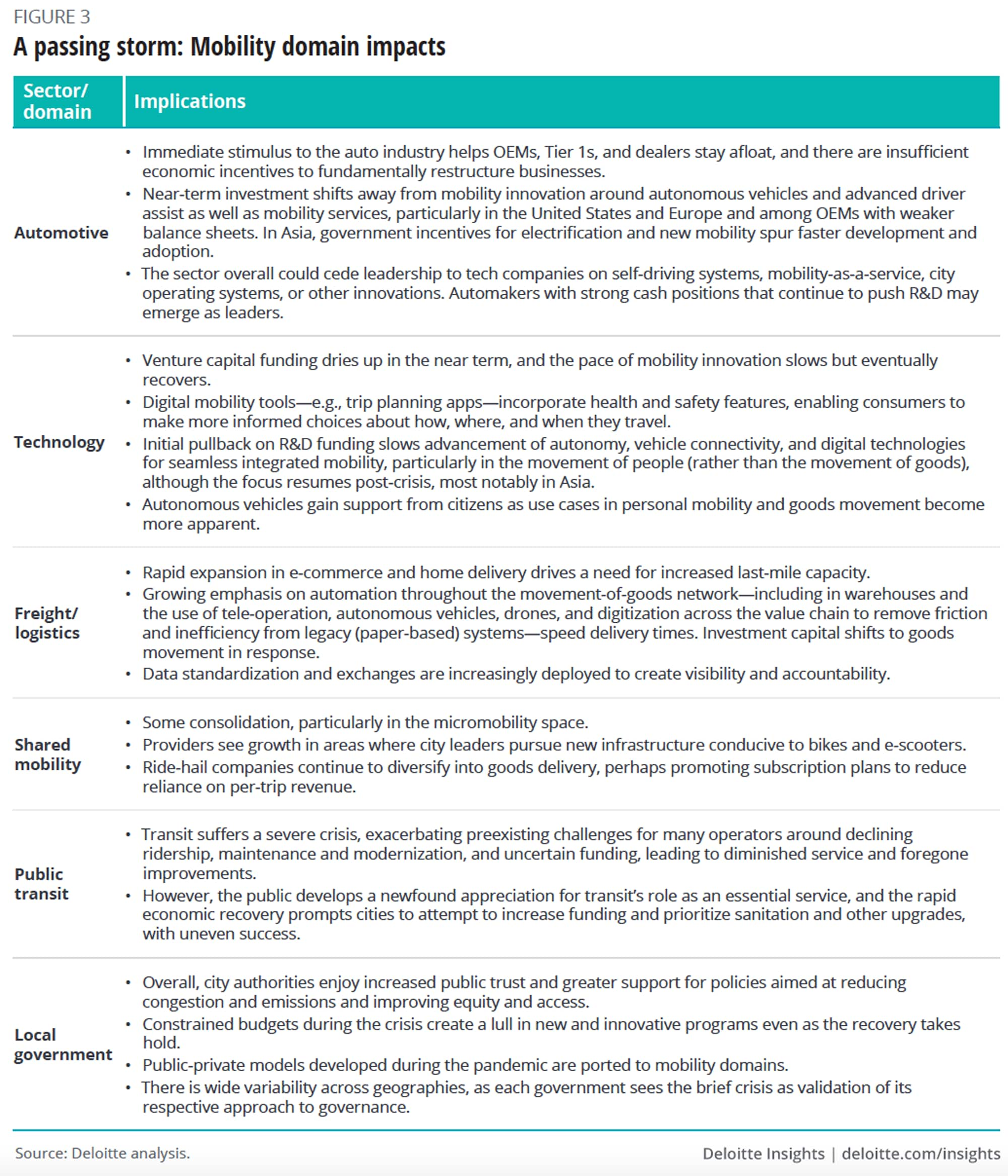
Scenario 2: Good company
Public goods, including transportation, are increasingly provisioned by the private sector. Mobility businesses, especially the largest tech-based providers, step in where government-provisioned services struggle to keep up, offering seamless transportation for their customers. Seeing mobility data’s utility in managing the pandemic, individuals are increasingly open to sharing information with the private sector; mobility technology advances quickly.
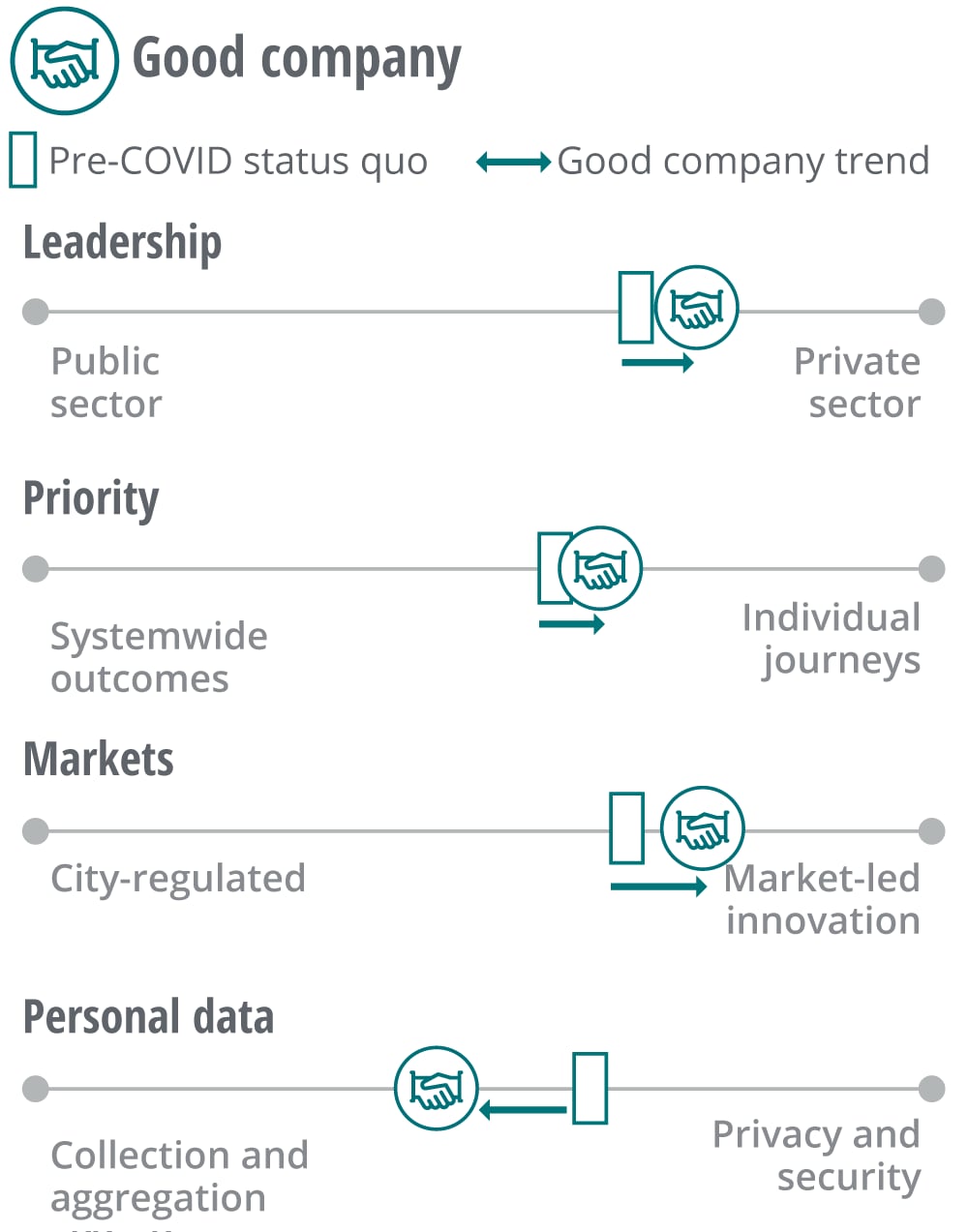
The private sector increasingly fills the voids left by the public sector in provisioning of services. Large, technology-based mobility companies thrive and take a leading position in mobility, collaborating with governments and legacy incumbent businesses, which find themselves with diminished leverage and relegated to junior-partner status. Privately owned on-demand flexible mobility (ride-hail, microtransit, micromobility) supplants public transportation in some routes and markets—or even becomes subsidized and acts as public transit. While privatized transit offers improved movement of people and goods for a portion of the population, it increases inequality, potentially tempered by a redoubled focus on stakeholder capitalism.
Large technology and mobility companies dominate the space, forging public-private partnerships and launching an array of innovation zones and “smart districts” in cities. The success of data-enabled businesses in monitoring and mitigating COVID-19 outbreaks translates to increased willingness of individuals to share mobility data with the private sector. That in turn fuels new mobility innovations and solutions around travel routing and planning and mobility-as-a-service. Cities suffer disproportionately and face a revenue crunch, ceding authority and regulatory power around mobility cost, access, and personal privacy and use of data.
EV adoption accelerates, driven by public attitudes, business innovation, and a regulatory environment increasingly shaped by socially conscious enterprises. Autonomous vehicle development accelerates, with more on-street testing.
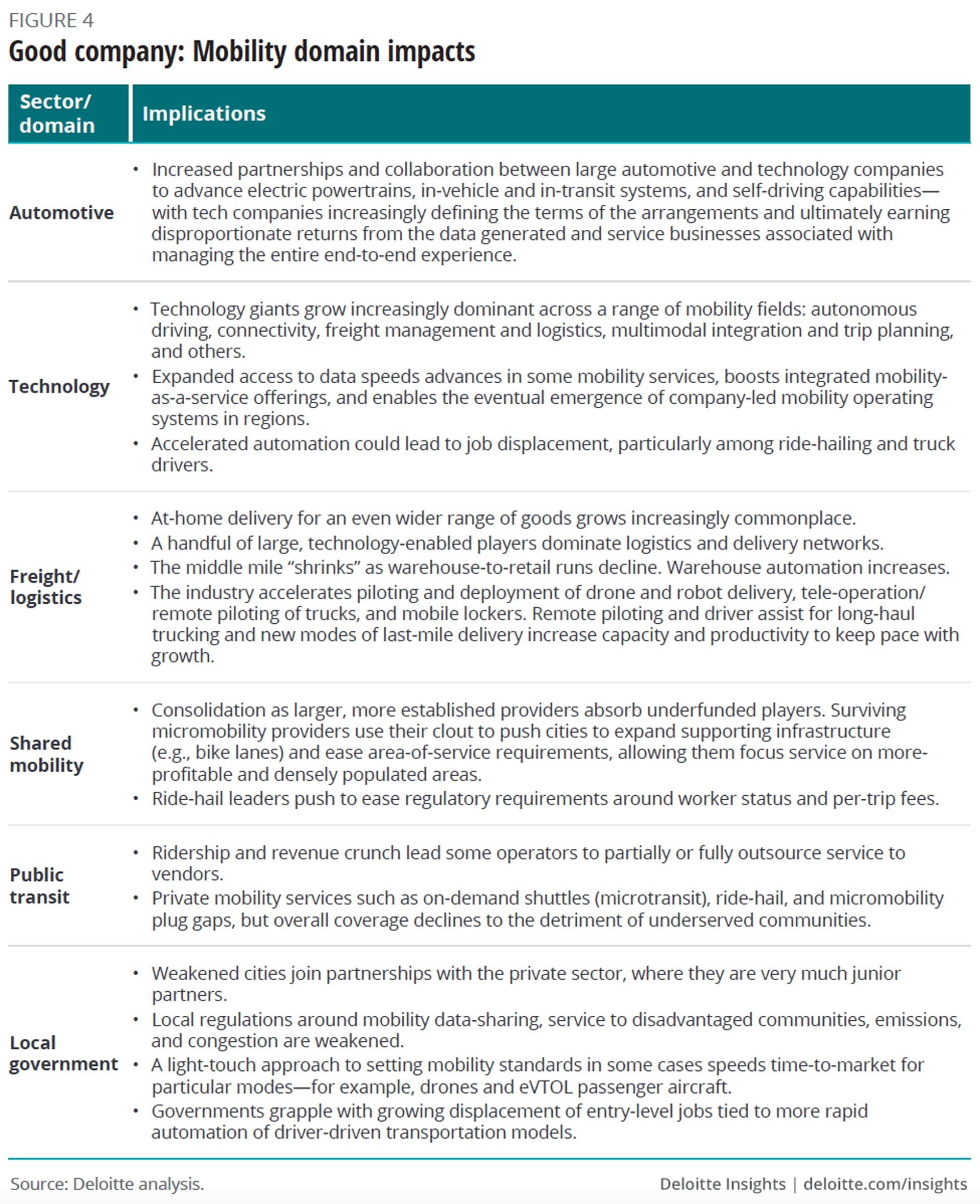
Sunrise in the east
The East Asian model’s perceived success extends from managing the pandemic to mobility. China, Singapore, Japan, and others become the leading hubs for mobility innovation and R&D, overshadowing Silicon Valley and Tel Aviv. The physical and digital value chains for electric vehicles, autonomous vehicles, and other technologies consolidate in the east, to the detriment of European and North American businesses. Active mobility management to address systemwide challenges around congestion and air quality becomes the norm, enabled by robust government data collection and analytics.
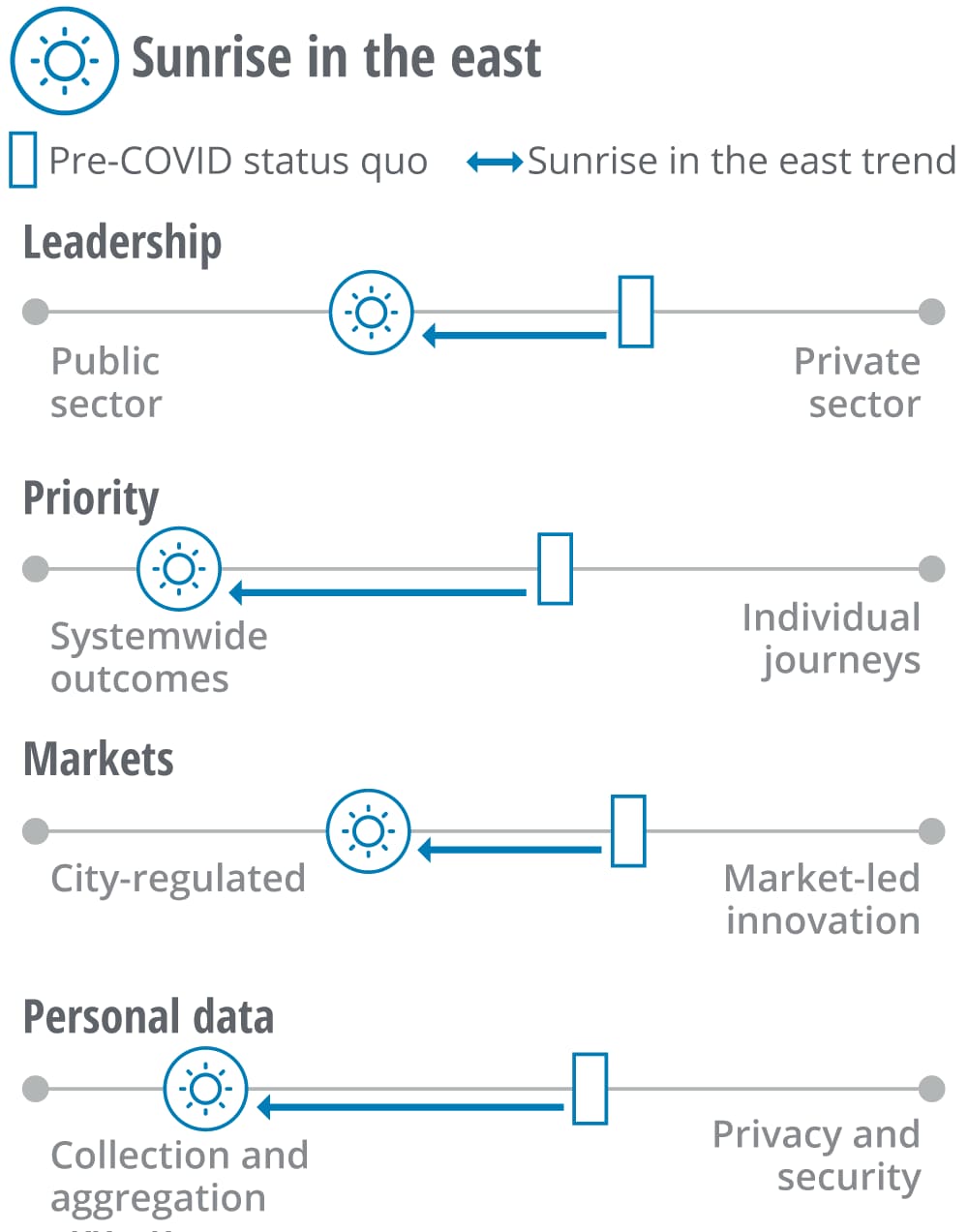
Asian companies across automotive, technology, and new mobility become globally dominant, supplanting their American and European rivals, serving both their booming home markets and consumers abroad. China increasingly dominates the battery supply chain, including key raw materials such as lithium and production technologies. Asian companies’ investments go global, buying stakes in emerging mobility technologies and securing key IP. Some Western governments, prodded by the private sector, enact additional protectionist measures to limit the adoption of foreign products, technologies, and solutions such as digital mobility platforms for cities and telecommunications hardware.
Cities globally embrace a more hands-on approach to managing mobility, with increased willingness to use policy tools championed in China and Singapore, such as license restrictions for new cars and dynamic road pricing. More expansive surveillance and data collection by government is increasingly seen as necessary and beneficial. Together, they enable multimodal trip planning with real-time traffic and transportation information to become the norm, along with more visible public health measures such as temperature checks and mandatory contact tracing.
Major investments in public transit are also seen as desirable, even as many governments struggle to fund them on the heels of an extended economic downturn; China backs some countries’ projects via its Belt and Road Initiative. Consumers gravitate toward long-term leasing, subscription, and rent-to-own models, pioneered in East Asia, as people shy from big-ticket purchases.
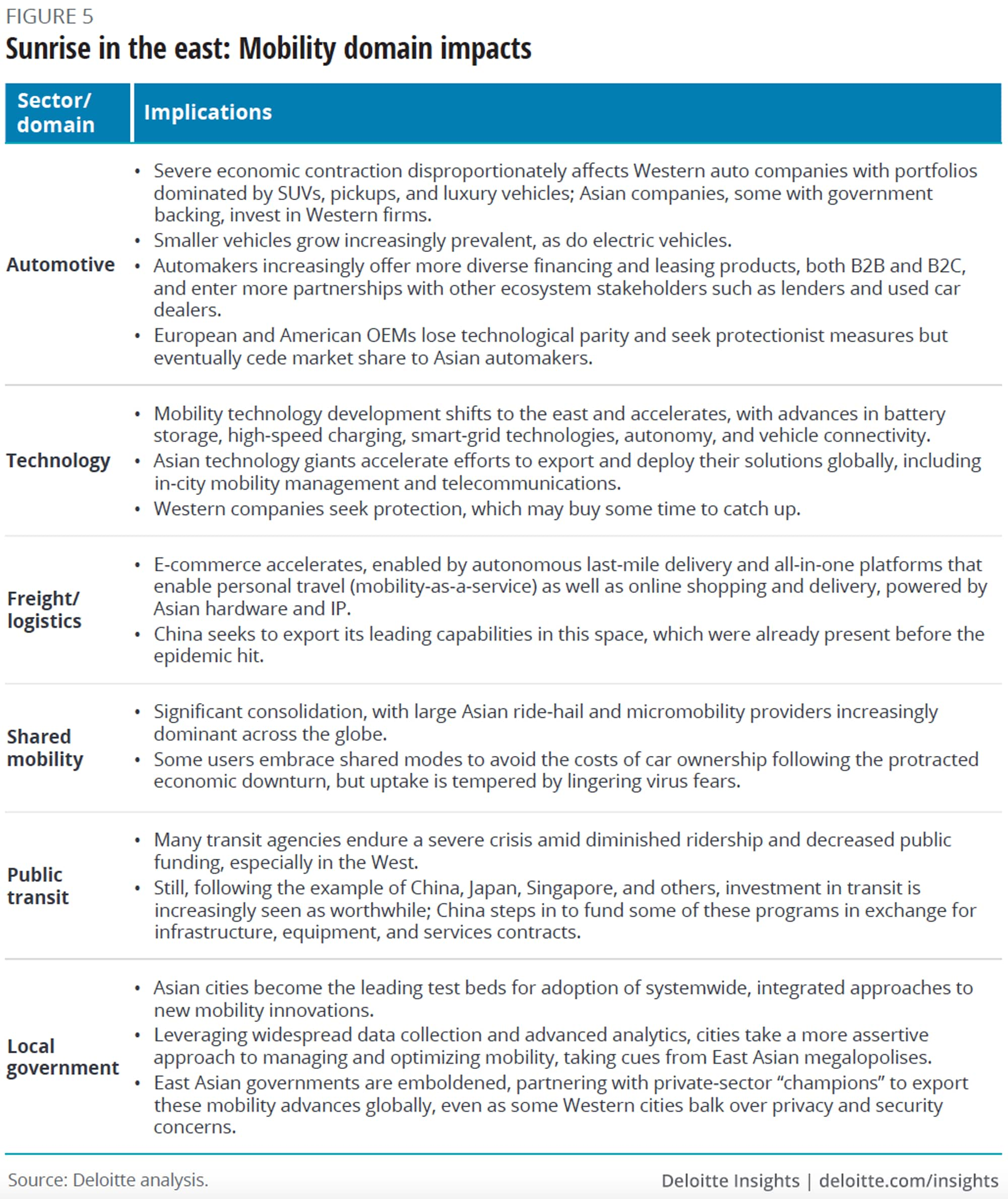
Lone wolves
National, regional, and local governments accrue greater authority as they lead efforts to combat the coronavirus. Cities force data-sharing and actively regulate mobility via top-down monitoring and control (for example, pricing), first as a way to control COVID-19 and then as a way to meet other, systemwide goals. Data privacy and cybersecurity give way to increased government oversight.
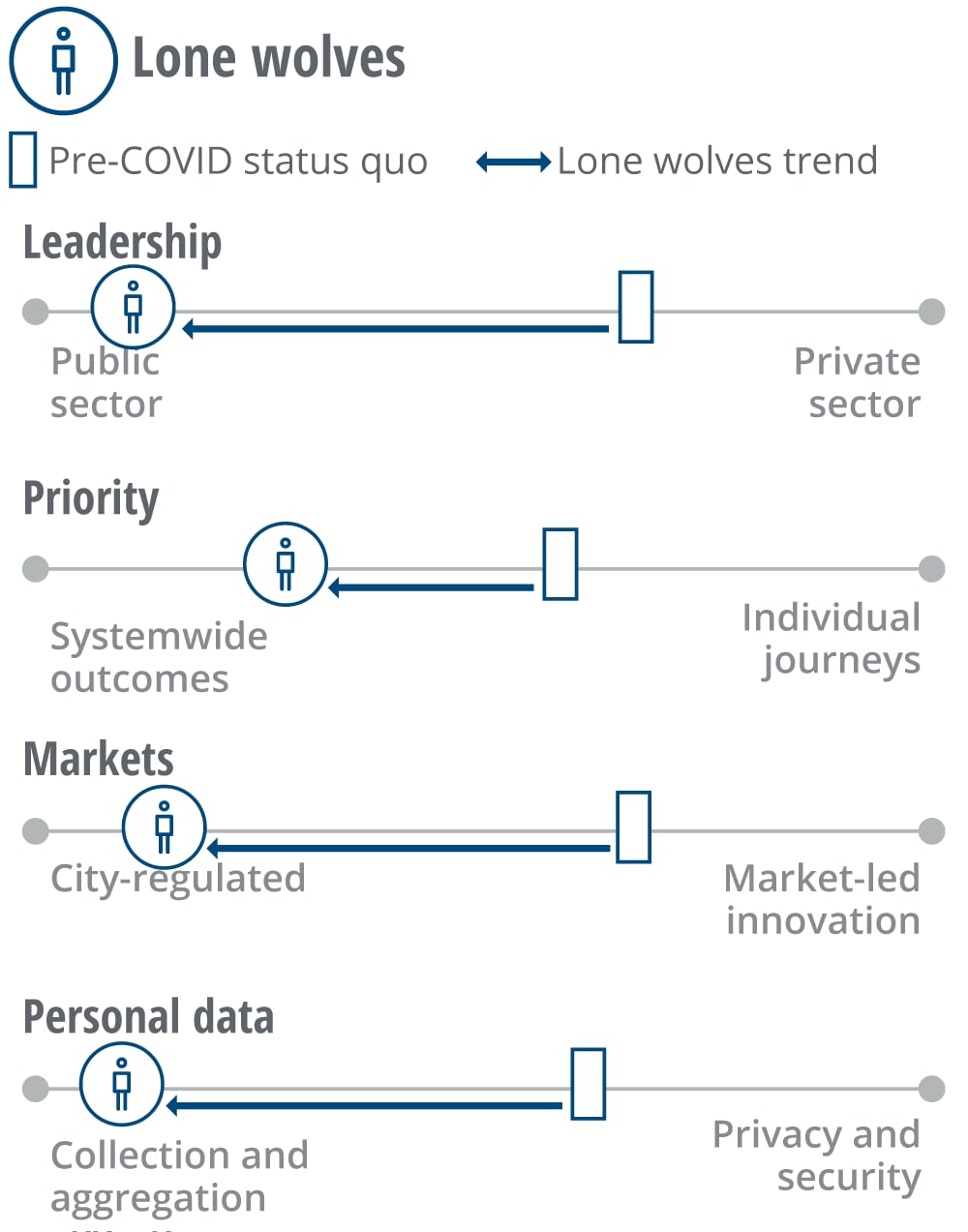
Cities, counties, states, and regions seek to exert increasing authority over the movement of people and goods in their jurisdictions, prompting numerous legal challenges from the private sector and other levels of government. Governments exert strong influence over capital flows, directing it toward “national champions” in traditional industries with an emphasis on job creation. Growing geopolitical tensions and virus-related readiness concerns make militaries a leading source of investments in mobility innovation. Energy and battery markets fragment and shift to local production, prompting some (for example, the United States) to continue to rely on internal combustion engines while others (China) double down on electric powertrains; absent robust battery supply chains, the development and deployment of some vehicle types (electric vertical-takeoff-and-landing craft and drones, for example) lags in particular markets.
There is a significant and sustained but uneven decrease in individual travel across all modes as waves of outbreak lead to shelter-in-place orders, permanent work-from-home arrangements for those able to do so, and increased use of telemedicine and digital services. Use of shared modes declines in favor of private, owned options, and remaining shared options adapt to provide new options for riders (for example, partitioned vehicles, self-cleaning interiors, and certified sanitized rides) as virus fears linger. Personal autonomous vehicles see limited deployment to the few who can afford them. Commutes for some lengthen as people with means flee dense cities for exurbs and shift to telework. Unprofitable or ill-funded mobility providers fold or are absorbed by better-capitalized competitors; in some cases, governments take stakes and microtransit, ride-hail, and micromobility providers become quasi-public transit.
Supply chains are dramatically shortened as countries force production to return onshore. There is a boom in e-commerce and last-mile delivery as brick-and-mortar retail collapses under the combination of persistent economic hardship and disease transmission fears, resulting in accelerated deployment of autonomous-vehicle technology for logistics.

“No regret” moves—and a fundamental choice
Uncertainty should not be synonymous with inaction. It is too soon to know which, if any, of these potential futures is most likely—or if we may end up in a hybrid world exhibiting features of one or more of them. It is not too early, however, to begin weighing the strategic and business model consequences of these scenarios and laying the groundwork for whatever mobility world ultimately emerges from the pandemic. As government recovery funding and regulatory changes start to be enacted, organizations will start to make investments and choices. These actions will begin to shape where they will play and how they will win in the future. It is critical that leadership teams evaluate the trade-offs associated with these choices now, before it may be too difficult, costly, and potentially late to alter the organization’s trajectory.
In the midst of the uncertainty, there are also some trends that we expect will take hold and persist, irrespective of which scenario plays out, specifically:
- Trip substitution via digitization. Telework, telemedicine, and e-learning are likely to become permanent fixtures for some portion of the population, reducing their need to access mobility. Some travel-heavy industries and functions, such as professional services and sales, may never return to precoronavirus levels of movement as people and organizations grow increasingly adept at conducting business virtually. The magnitude of these shifts, and whether it creates a material change in overall demand (for example, miles traveled or mode choice), will depend largely on how long the pandemic and associated stay-at-home orders persist.
- Action: Companies and mobility operators should assess their customer base and gauge the potential long-term impact on travel patterns. What proportion are likely to be able to shift to a permanent work-from-home arrangement? Do you rely on commuting or leisure travel? In-depth consumer data, including surveys and demographics, should be used to create a detailed picture, as trends are likely to be highly idiosyncratic.
- A new focus on—and expanded definition of—safety. Safety in mobility has long meant avoiding car crashes or preventing crime on buses and subways. As people begin to travel again, a “safe” trip will likely also mean one that is sanitary and hygienic. We can expect a wide range of measures to be deployed where people gather to travel together: health checks or thermal scans before boarding a shared vehicle or entering a terminal, improved cleaning procedures, reconfigured seating and partitions to create physical distancing, cashless systems to reduce the exchange of money, and more. We anticipate greater use of easy-to-clean materials for vehicle interiors, including self-cleaning ones, and new certification standards to verify cleanliness.
- Action: Every organization needs to undertake a comprehensive assessment of its end-to-end operations and interactions with customers through the lens of health and sanitation. Deploying best-in-class measures—and communicating them effectively to users and the public—is likely to become the price of admission for doing business in a postcoronavirus world. That’s likely to be doubly true for shared mobility (ride-hailing, on-demand shuttles, bikeshare, shared e-scooters) and mass transit.
- Growing reliance on e-commerce and home delivery. The perceived health risks of venturing into crowded stores coupled with stay-at-home orders is accelerating the rapid shift toward online retail and home delivery. We will likely see increased attention to, and innovation around, supply chain optimization, long-haul trucking, and last-mile freight movement, with expanded testing and deployment of automated delivery via robots and drones, as well as remote operation and autonomous drive for long-haul trucking.
- Action: Explore ways to capitalize on e-commerce and home delivery. Online retail and last-mile fulfillments were already growing rapidly precoronavirus, and the pandemic will likely accelerate the trend. Companies across the mobility spectrum should consider how they can best move into the space. That could mean a renewed emphasis on commercial vehicles, accelerating deployment of delivery solutions (such as autonomous robots or drones), or shifting resources from the movement of people to the movement of goods, as some ride-hailing providers have done.
- A reconfigured mobility landscape. Few if any across the transportation ecosystem will survive these crises unscathed. Some players will exit, new entrants may rise, partnerships will be forged, and investments will ebb, flow, and be reallocated. New consumer preferences, new use cases, and new business models are likely to emerge. Mobility, already a highly dynamic space, looks set to be even more fluid over the coming months.
- Action: Take stock of your current ecosystem partners and assess what new collaborations might be needed. Develop a robust and active market, competitor, and ecosystem sensing capability to inform the effort. Public-private engagement and cooperation will likely feature prominently in any mobility future, so actively building those relationships now could pay dividends.
Beyond these “no regret” considerations, each scenario has room for a wide spectrum of mobility outcomes. There is a world in which the virus passes relatively quickly and the economic damage is acute but short-lived—and which sees people retrench into old movement patterns, dominated by private cars, powered by fossil fuels, and with even fewer viable alternatives than what we’ve known over the last several years. Likewise, a scenario that sees ongoing waves of infection, the breakdown of governmental cooperation, and the rise of more intrusive surveillance could nonetheless find pockets of a new mobility landscape, with reinvigorated public transit, a rekindled enthusiasm for walking and cycling, cleaner vehicles, and the use of technology to enable more efficient and convenient journeys for people and goods.
Which of these outcomes is most probable hinges critically on the decisions made by myriad stakeholders—including readers such as you—over the coming months. The fundamental choice, which will manifest in a thousand variations across the mobility ecosystem, is simple: Do they fall back on old ways, abandoning new modes and services and focusing on legacy businesses or departing the mobility landscape altogether? Or do they maintain and even redouble efforts to forge new approaches that propel us to a reimagined mobility system? The latter path takes courage, conviction, and, yes, a greater tolerance for risk, and may be beyond the wherewithal of many. As we have written about extensively, this future is dependent upon a new ecosystem emerging, where roles shift, as do the sources of value creation. Like all crises, this one offers opportunities to conceive of different ways to establish success in a mobility landscape undergoing significant change.
As you consider that essential choice and these scenarios, challenge yourself to imagine how the things you were certain would happen could now be on a different course. Avoid the temptation to conclude that the crisis will accelerate the changes you already expected or believed were inevitable. Ask yourself:
- Which of your previous expectations need to be rethought? What prospects that seemed unlikely or years away could be accelerated, such as shifts in travel behavior and preferences or the deployment of autonomous vehicles?
- What might consumers value in these different worlds: cost, convenience, speed, safety, privacy? How might that vary across key variables—for example, region and demographics?
- What are the biggest threats to your current business in these worlds?
- How does the different roles of government in these scenarios influence your strategy and freedom to operate?
- What new providers, companies, business models, and ecosystems might emerge? Which existing companies are best positioned to succeed?
- What capabilities, relationships, and assets are important in these worlds?
Stakeholders will need to closely track both the overall situation (pandemic severity and how governments react) and their specific mobility environment to gauge which future—or combination of futures—is beginning to emerge, and be prepared to pivot their response accordingly. Agility is a trait many organizations aspire to but few attain9—and it may be the most important capability of all going forward.
Conclusion: Making the world in which we want to live
In forthcoming articles, Deloitte will be exploring the implications of coronavirus on the future of mobility in greater depth, including diving deeper in the potential future scenarios, their key drivers, and their implications for different players in the mobility space.
While the ability to shape which mobility future comes to pass is beyond any single actor’s control, we are hardly bystanders. Every participant in the mobility ecosystem—down to every individual—can influence its direction through the choices we make in the coming months. And collectively, by convening and activating that ecosystem, we can create monumental change for the betterment of society.
© 2021. See Terms of Use for more information.
Explore COVID-19 resources
-
The essence of resilient leadership: Business recovery from COVID-19 Article5 years ago
-
The heart of resilient leadership: Responding to COVID-19 Article5 years ago
-
ConsumerSignals Interactive1 week ago
-
Embedding trust into COVID-19 recovery Article5 years ago
-
The economic impact of COVID-19 (novel coronavirus) Article5 years ago
-
Global Weekly Economic Update Article5 days ago















